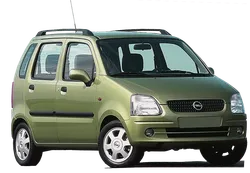

Opel Agila - Opel Agila A Overview
Discover the Opel Agila and its A generation, a compact solution in Portugal. Explore its features, specifications, and performance for your next car choice.
The Opel Agila A, a modest yet ingeniously designed city car, made its debut in 2000, representing a collaboration between two automotive giants: Opel and Suzuki. This compact vehicle was not only ...
Technical Specifications
Select Version
Dimensions
Engine
Driving
Others
History and Features
Mycarro AI
Apr 27, 2025
The Opel Agila A, a modest yet ingeniously designed city car, made its debut in 2000, representing a collaboration between two automotive giants: Opel and Suzuki. This compact vehicle was not only engineered to be space-efficient but also aimed at providing an economical and practical solution for urban commuters. Manufactured until 2007, the Agila A left a significant mark in the vehicular landscape of the early 2000s.
Design and Features
The Opel Agila A stood out due to its quirky and compact design. With a height of 1.59 meters and a length of just over 3.4 meters, it offered an unusually spacious interior for a vehicle of its size. The tall stance and large windows made it feel more open and airy, lending itself well to city driving. Its design catered predominantly to practicality, making use of every inch to create ample cargo space. The rear seats could be folded down to expose a larger boot area, further enhancing the vehicle's versatility.
Inside, the Agila A featured simple yet functional interiors, designed with the user experience in mind. Although not overly luxurious, it delivered essential amenities that appealed to budget-conscious consumers. The dashboard layout was straightforward, making navigation intuitive. The seating was comfortable, with decent legroom for passengers in both the front and rear.
Performance and Specifications
Under the hood, the Opel Agila A came equipped with a variety of engines, driving its appeal as an economical urban vehicle. Buyers could choose between a 1.0-liter three-cylinder engine or a more robust 1.2-liter four-cylinder option. The latter provided a respectable output, allowing the Agila to perform well in city traffic while also maintaining efficient fuel consumption. The manual transmission offered a delightful driving experience, learning to navigate busy streets with agility.
One of the appeals of the Opel Agila A was its performance on the road. With a small turning radius, it was perfect for maneuvering through tight urban landscapes. Its suspension was tuned for comfort, absorbing uneven surfaces with ease. Though it wasn't a performance vehicle by any means, it adequately fulfilled the needs of everyday drivers looking for reliability.
Safety Features and Ratings
Safety was an essential aspect of the Opel Agila A’s engineering. Despite its small size, the car came with a variety of safety features that were progressive for its class in the early 2000s. Standard features included driver and passenger airbags, antilock brakes (ABS), and, for certain models, electronic stability control. These features contributed to a satisfactory safety rating, reassuring potential buyers about their decision to choose this compact car.
Market Position and Competition
During its production run, the Agila faced stiff competition from other city cars, such as the Fiat Panda, Peugeot 107, and Toyota Aygo. However, the Agila A carved a niche due to its unique design and affordability. Its competitive pricing made it an attractive option for first-time car buyers and those looking for economical transportation solutions.
Opel marketed the Agila with an emphasis on practicality and value for money, appealing to consumers who prioritized functionality over luxury. This marketing strategy proved effective, helping the car gain traction in markets across Europe.
The Legacy of Opel Agila A
As production of the Opel Agila A ended in 2007, the model left a legacy that would influence subsequent city car designs. Although it was eventually replaced by the Agila B—which further refined the compact concept—the original Agila A remained a beloved option for those who appreciated its practicality and charm.
In conclusion, the Opel Agila A encapsulated the essence of early 2000s urban car design. Its focus on space efficiency, affordability, and basic functionality struck a chord with urban dwellers, making it a memorable player in the city car market. With its quirky design and reasonable performance, the Agila A stands as a nostalgic reminder of a simpler time in automotive history.
